Have you ever heard someone say they’re never drinking again once the hangover hits?
Then the hangover fades…they drink again…and repeat the cycle.
That’s how I feel right now.
No, I’m not referring to drinking. I’m talking about falling off the discipline cliff.
After taking my biggest loss of the year last week…
I told myself I would be more disciplined, patient, and focused on my best setups.
But just two trades later…I got impatient and overly aggressive…causing me to take another bad loss.
Luckily, I have thousands of trades under my belt, over 7,700 you can see on Profit.ly, and more than $7.4 million in trading profits.
I’ve overcome adversity, gotten out of slumps, and turned my trading around countless times.
And this time won’t be any different.
Identify Your Trigger Points

2025 Millionaire Media, LLCFor the most part, I see the market well.
And in terms of my stock selection, it’s pretty strong.
But where I’m failing is my execution.
The panic dip buy has been working perfectly. However, I’ve been too aggressive with my entries and getting into the plays WAY too early.
I always preach to my students to be patient and wait for the right opportunities.
Yet I wasn’t following my own advice.
Why?
Because I’ve been forcing trades, I’ve focused more on making money and less on my execution, which is the opposite way to think if your goal is to be profitable.
I’ve been frustrated because I’m finding winning plays, but the timing has been off…I’m zigging when I should be zagging…and zagging when I should be zigging.
The frustration has led me to add to losing positions and overtrade.
On the bright side, I’m aware of what my issues are. And I’m taking responsibility for them.
It’s easier to attack a problem if you know what it is.
That’s why I make videos highlighting my bad trades and share them with my students.
It highlights what I need to fix and allows my students to learn from my mistakes.
Your Self-Talk

2025 Millionaire Media, LLCI know I’m off my game and am working my way through fixing my issues.
It’s nothing personal.
However, too many traders are taking losing personally.
Making money in the markets doesn’t make you a good person. But traders love to beat themselves up when they’re losing.
You’ve got to stay positive. And understand that losing is part of trading and that valuable lessons can be learned from losses.
To trade your best, you have to be confident. Knocking yourself down with negative self-talk won’t help you reach your goals faster.
Your self-talk should be positive.
For example, I’ve been jumping into trades too early when I should have waited more patiently for a better dip buy.
I tell myself I will be more patient on the next trade. I will exercise greater discipline and play my best setups.
More Breaking News
- Gryphon Digital Surges: What Now?
- Wynn Resorts Expands European Footprint with Mayfair Acquisition
- QuantumScape’s Stunning Stock Surge: What’s Next?
I even tell myself to think like a retired trader. Someone out of the game and only willing to jump back in if they find a play so compelling they would regret not taking it.
Stick to Your Rules

2025 Millionaire Media, LLCMy number one rule is to cut losses quickly. And while I’ve done a good job at that, I’ve traded too aggressively, resulting in bigger losses than I’m used to taking in this market.
My rules are relatively simple:
- Always cut losses quickly
- Expect the worst out of every company/promoter
- Focus on making contact on the ball (singles vs. home runs)
- Ride the hype, but never believe it
- Never follow alerts or rely on others for picks
Now, I know these sound pretty general. But these rules help build the foundation of my trading. And they keep me in check.
Your rules might be completely different. And that’s okay if they work for you.
Good rules will keep you out of trouble.
You won’t get out of a trading slump by breaking rules.
That’s why it’s a good practice to review your trading rules each day before trading.
Bottom Line
Climbing out of my April hole won’t be easy. But if I follow these steps I’ve laid out for you, I think it’s possible.
For the next few trading sessions, I will focus on safety, keeping my position size small until I get my timing back, paying closer attention to the setups, and not forcing the action.
Let me know in the comment section below if you’re dealing with any of these issues.
If you want to learn more about my challenge, check this out.







Leave a reply